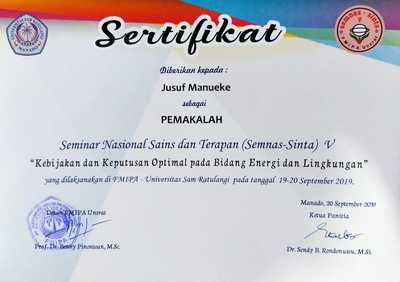Manueke, Jusuf and Mamahit, Eva and Assa, Berty H.
(2019)
TEKNOLOGI PENGENDALIAN HAMA PENGGEREK BATANG CENGKEH (Hexamitodera semivelutina Hell.) YANG EFISIEN, EFEKTIF DAN RAMAH LINGKUNGAN DI KECAMATAN KOMBI KABUPATEN MINAHASA.
In: SEMINAR NASIONAL SAINS DAN TERAPAN 2019, 19-20 SEPTEMBER 2019, FAKULTAS MIPA UNIVERSITAS SAM RATULANGI.
Abstract
ABSTRAK
Tujuan penelitian adalah memdapatkan teknologi pengendalian hama penggerek batang cengkeh H. Semivelutina yang tepat guna, ramah lingkungan dan mudah dilakukan petani. Penelitian menggunakan Rancangan Acak Kelompok (RAK). Penentuan kebun cengkeh dan pohon cengkeh contoh mengunakan “purposisive sampling method” yaitu dilakukan dengan cara memilih pohon cengkeh yang ada lubang gerekan penggerek batang cengkeh yang masih aktif. Analisis Data mdnggunakan menggunakan program SPSS Ver. 21. Jika diperoleh hasil yang signifikan antar perlakuan maka pengujian dilanjutkan uji beda nyata terkecil (BNT). Hasil penelitian menunjukkan bahwa perlakuan ekstrak buah lanta konsentrasi 20% menyebabkan tingkat penyembuhan lubang gerekan H. semivelutina tertinggi yaitu mencapai 100%, kemudian diikuti perlakuan ekstrak buah bitung konsentrasi 20% yang menyebabkan tingkat penyembuhan lubang gerekan 90%, ekstrak buah lanta dan buah bitung kansentrasi 15% dan 10% menyebabkan tingkat penyembuhan lubang gerekan 75% dan 55%, eksrak buah lanta konsentrasi 5% menyebabkan tingkat penyembuhan lubang gerekan 35%, dan ekstrak buah bitung konsentrasi 5% memiliki tingkat penyembuhan lubang gerekan terendah yaitu 30%. Konsentrasi eksrak buah lanta dan buah bitung yang efektif dan efisien mengendalikan H. semivelutina di Kecamatan Kombi Kabupaten Minahasa adalah 15% dan 20% larutan jadi. Cara aplikasi yaitu menyemprotkan langsung pada lubang gerekan larva H. semivelutina yang aktif kemudian ditutup dengan tanah liat steril.
Kata kunci: Hexamithodera semivelutina, metode purposive sampling, ekstrak buah lanta, ekstrak buah bitung.
ABSTRACT
The purpose of this research is to get the right, environmentally friendly control technology of clove stem borer H. Semivelutina pest and easy to do farmers. The study used a randomized block design (RBD). Determination of clove gardens and clove trees for example using the "purposive sampling method" which is done by selecting clove trees that have clove stem borer holes that are still active. Data analysis using SPSS Ver. 21. If significant results are obtained between treatments, then the test is continued with the smallest significant difference test (LSD). The results showed that the treatment of 20% concentration of lanta fruit extract caused the highest cure rate of H. semivelutina hoist hole which reached 100%, then followed by 20% concentration of bitung extract treatment which led to 90% cure hole extraction rate, lanta fruit and bitung fruit extract concentrated 15% and 10% cause 75% and 55% grinding hole healing rates, 5% concentration of lanta fruit extract causes 35% grinding hole healing rate, and 5% concentration of bitung extract has the lowest cure hole rate of 30%. The effective and efficient extract of lanta and bitung fruit extracts to control H. semivelutina in Kombi District of Minahasa Regency is 15% and 20% of finished solutions. The method of application is to spray directly on the active larval hole H. semivelutina then covered with sterile clay.
Keywords: Hexamithodera semivelutina; purposive sampling method; Lanta fruit extract; Bitung fruit extract.
Actions (login required)
 |
View Item |
![[img]](http://repo.unsrat.ac.id/2705/4.hassmallThumbnailVersion/SERTIFIKAT_SEMNAS-SINTA_V_FMIPA_UNSRAT__MANADO_2019.jpeg)



